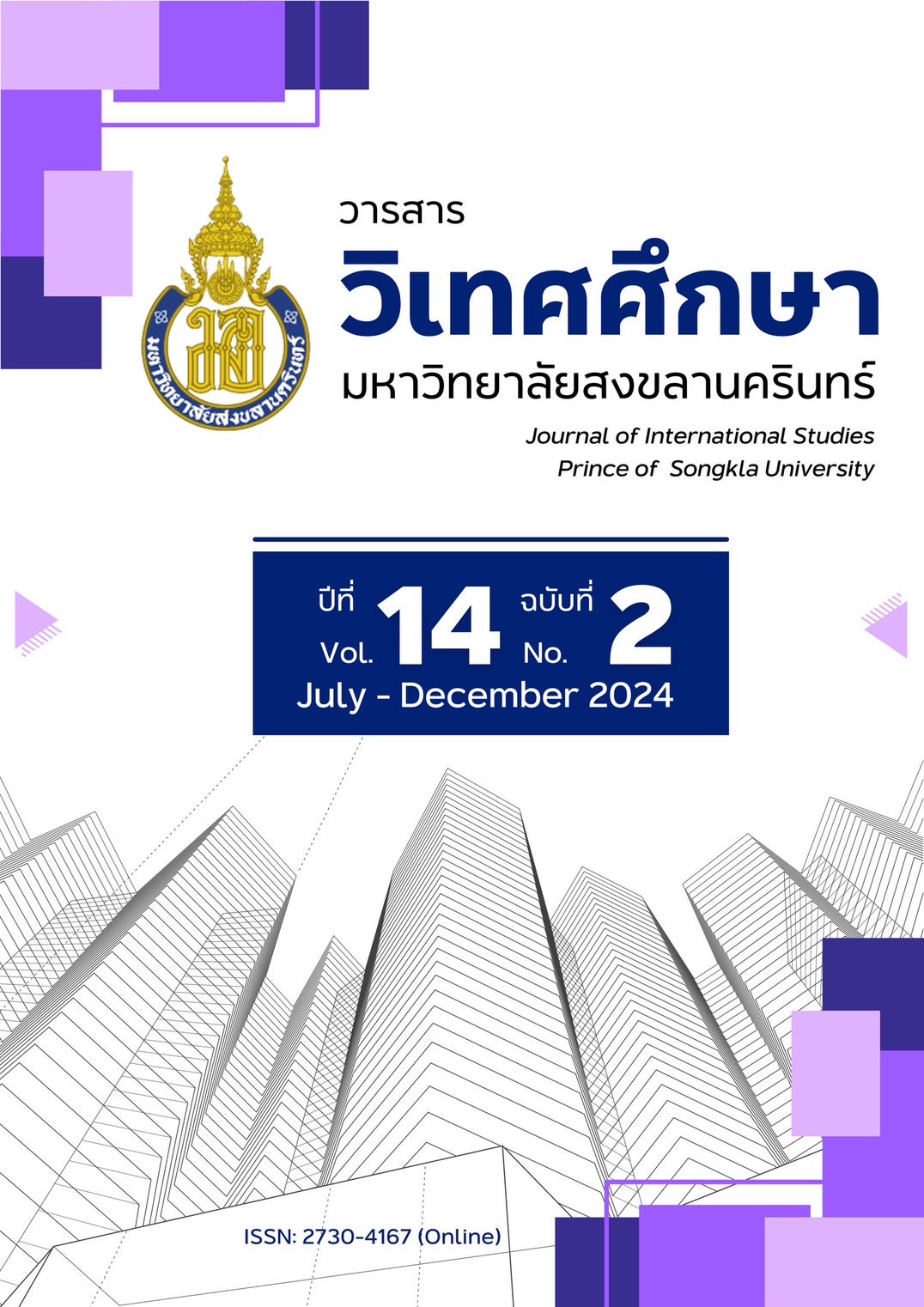Building Brand Awareness of Fusion Restaurant Business in Narathiwat Province
Main Article Content
Abstract
Building brand awareness is trustworthy and memorable among consumers; it is of the utmost importance for today's service organizations. This qualitative research aimed (1) to analyze brand identity, and (2) to investigate communication methods, and strategies used to build up brand awareness for the fusion restaurant business in Narathiwat province. Data collection tool was in-depth interviews with entrepreneurs and employees of five fusion restaurants, consisting of two to three people each, totaling 11 informants, using a purposive sampling method. Additionally, the researchers analyzed messages conveyed through logos, images, slogans, and brand graphics of the case studies. The research results showed that the brand identity of the fusion restaurants can be divided into five categories: (1) Gallery cafe' & bistro; (2) Authentic Italian homemade pizza; (3) Halal Korean food; (4) Healthy food, and (5) Contemporary Thai food. Those restaurants in research studies have similar methods of building brand awareness. They used social media as the main channel, and created great content to attract consumers via integrated online/offline advertising and public relations. They also employed influencers to promote and review products, as well as special promotions and discounts, using a viral marketing strategy.
Article Details

This work is licensed under a Creative Commons Attribution-NonCommercial-NoDerivatives 4.0 International License.
Statements and opinions expressed in articles herein are those of the authors and do not necessarily reflect the position of the editors or publisher.
Article, information, text, image, etc. which are published in Journal of International Studies, belong to Journal of International Studies. If anybody or any organization would like to use part or whole of them, they must receive written permission from Journal of International Studies before usage.
References
จุฑามณี คุณชาไพร ลัสดา ยาวิละ และรัตนา สิทธิอ่วม. (2566). การสื่อสารการตลาดแบบบูรณาการ (IMC) และการบอกต่อแบบ ปากต่อปากบนสื่ออิเล็กทรอนิคส์ (e-WOM) ที่ส่งผลต่อคุณค่าตราสินค้าของผู้บริโภคที่สนใจซื้ออสังหาริมทรัพย์ในเขตจังหวัดภาคเหนือ. วารสารวิชาการมหาวิทยาลัยราชภัฏเพชรบุรี, 13(2), 62-71. https://journal.pbru.ac.th/admin/upload/article/8952-2023-10-11.pdf
จุฑารัตน์ ชัยบรรหาร และทรงพร หาญสันติ. (2561). อัตลักษณ์และภาพลักษณ์ตราสินค้าที่มีอิทธิพลต่อการตัดสินใจซื้อรถยนต์ Ford ประเภท Pick-Up ของผู้บริโภคในเขตพื้นที่กรุงเทพมหานคร. วารสารการจัดการสมัยใหม่, 16(1), 229-238. https://so04.tci-thaijo.org/index.php/stou-sms-pr/article/view/134549/100681
ชัชวรินทร์ พูลสวัสดิ์. (2566). การสร้างแบรนด์สินค้าให้ประสบความสำเร็จในยุคดิจิทัล. Interdisciplinary Academic and Research Journal, 3(6), 141-152. https://so03.tci-thaijo.org/index.php/IARJ/article/view/271017
ธนันท์กาญจน์ สมทรัพย์ สมเดช รุ่งศรีสวัสดิ์ และบัณฑิต ผังนิรันดร์. (2564). อิทธิพลของการสร้างแบรนด์องค์กร การตลาดเชิง กิจกรรมและนวัตกรรมที่มีผลต่อความภักดีของลูกค้าในวิสาหกิจขนาดกลางและขนาดย่อม (SMEs) ในประเทศไทย. วารสารวิชาการครุศาสตร์อุตสาหกรรม พระจอมเกล้าพระนครเหนือ, 12(1), 182-192. http://www.journal.fte.kmutnb.ac.th/download/v12n1/20.pdf
นิตนา ฐานิตธนกร. (2555). อิทธิพลของการบอกต่อบนโลกอินเทอร์เน็ต. วารสารนักบริหาร, 32(1), 17-22. https://www.bu.ac.th/knowledgecenter/executive_journal/jan_mar_12/pdf/aw03.pdf
นิวัติ จันทราช และนนทิพันธ์ ประยูรหงส์. (2564). ปัจจัยเชิงสาเหตุของการจัดการแบรนด์ในมุมมองของลูกค้า โดยมีคุณลักษณะของลูกค้าเป็นตัวแปรกำกับที่มีอิทธิพลทางตรงและทางอ้อมต่อการตัดสินใจซื้อสินค้าผ่านออนไลน์ของผู้บริโภคในประเทศไทย. วารสารวิชาการ สถาบันวิทยาการจัดการแห่งแปซิฟิค สาขามนุษยศาสตร์และสังคมศาสตร์, 7(3), 629-646. https://so05.tci-thaijo.org/index.php/pacific/article/view/252902
ประไพพิมพ์ สุธีวสินนนท์ และประสพชัย พสุนนท์. (2559). กลยุทธ์การเลือกตัวอย่างสำหรับการวิจัยเชิงคุณภาพ. วารสารปาริชาต มหาวิทยาลัยทักษิณ, 29(2), 31-48. https://so05.tci-thaijo.org/index.php/parichartjournal/article/view/69461/56396
พิทยุช ญาณพิทักษ์. (2566). การสร้างคุณค่าของแบรนด์ของธุรกิจบนตลาดออนไลน์. วารสารวิจัยมหาวิทยาลัยเวสเทิร์น มนุษยศาสตร์และสังคมศาสตร์, 9(1), 275-288. https://so04.tci-thaijo.org/index.php/WTURJ/article/view/262978/179163
ภาวิณี โสธายะเพ็ชร. (2567, 12 มกราคม). “อาหาร” พื้นฐานการผลิตคนมีคุณภาพ. กรุงเทพธุรกิจ. https://www.bangkokbiznews.com/health/social/1108014
รอยนวล. (2556, 1 พฤศจิกายน). จุดฟินแห่งฟิวชันฟู้ด. โพสต์ทูเดย์. https://www.posttoday.com/travel/256483
ศูนย์วิจัยกสิกรไทย. (2565, 25 ตุลาคม). มูลค่าธุรกิจร้านอาหารขยายตัวในปี 2565-2566 ท่ามกลางโจทย์ท้าทายด้านต้นทุนและการรักษากำไรของผู้ประกอบการ (กระแสทรรศน์ ฉบับที่ 3352). https://www.kasikornresearch.com/th/analysis/k-econ/business/Pages/restaurant-z3352.aspx
สานิตย์ หนูนิล. (2563). การวิเคราะห์องค์ประกอบรูปแบบการดำเนินชีวิตของคนรุ่นใหม่ในสังคมชนบทของประเทศไทย. วารสารสังคมศาสตร์ มหาวิทยาลัยศรีนครินทรวิโรฒ, 23(1), 169-193. https://ejournals.swu.ac.th/index.php/JOS/article/view/12909/10623
สุนทรีย์ สองเมือง. (2566). ผลกระทบของอิทธิพลทางสื่อออนไลน์และการรับรู้ตราสินค้าที่ส่งผลต่อการตัดสินใจซื้อสินค้าผ่านแพลตฟอร์มโซเชียลมีเดียของผู้บริโภคในเขตกรุงเทพมหานคร. วารสารมนุษยศาสตร์และสังคมศาสตร์ มหาวิทยาลัย ราชพฤกษ์, 9(1), 104-118. https://so03.tci-thaijo.org/index.php/rpu/article/view/267843/177393
สุภัททา ปิณฑะแพทย์. (2564). การสัมภาษณ์เพื่อการวิจัยเชิงคุณภาพ. วารสารพัฒนาธุรกิจและอุตสาหกรรม, 1(3), 1-3. https://so15.tci-thaijo.org/index.php/Journalbid/article/view/110/37
แสงตะวัน เพชรสุวรรณ. (2564). อิทธิพลของการรับรู้ตราสินค้าและความไว้วางใจต่อความตั้งใจเชิงพฤติกรรมของผู้บริโภคผลิตภัณฑ์ที่เป็นมิตรต่อสิ่งแวดล้อม. วิทยานิพนธ์บริหารธุรกิจมหาบัณฑิต, มหาวิทยาลัยศิลปากร. http://ithesis-ir.su.ac.th/dspace/bitstream/123456789/3964/1/61602329.pdf
อาทิตยา ดาวประทีป. (2559). การรับรู้ตราสินค้าและผู้มีอิทธิพลต่อตราสินค้าบนสื่อสังคมออนไลน์ที่ส่งผลต่อการตัดสินใจซื้อเครื่องสำอางเกาหลีของผู้บริโภคในเขตกรุงเทพมหานคร. การค้นคว้าอิสระบริหารธุรกิจมหาบัณฑิต, มหาวิทยาลัยกรุงเทพ. http://dspace.bu.ac.th/jspui/bitstream/123456789/3028/3/artitaya_daop.pdf
ฮัมเดีย มูดอ และสากีเราะ แยนา เบ็ญฮารูน. (2566). การวิเคราะห์วัฒนธรรมมลายูผ่านอัตลักษณ์ตราสินค้าของร้าน Bagus Chicken ปัตตานี. วารสารมหาวิทยาลัยราชภัฏยะลา, 18(2), 112-121. https://so04.tci-thaijo.org/index.php/yru_human/article/view/258864/179322
Aaker, D. A. (1991). Managing brand equity: Capitalizing on the value of a brand name. New York: Free Press.
Huete-Alcocer, N. (2017). A literature review of word of mouth and electronic word of mouth: Implications for consumer behavior. Frontiers in Psychology, 8(1256), 1-4. https://www.frontiersin.org/articles/10.3389/fpsyg.2017.01256/ full
Indriarti, R., Hurriyati, R., Dirgantari, D. P., & Harisandi, P. (2024). Future directions in strategic brand management research using bibliometric analysis: A decade review. Jurnal Riset Multidisiplin dan Invovasi Teknologi, 2(1), 375-385. https://doi.org/10.59653/jimat.v2i01.510
Krungthai Compass. (2566, 11 กันยายน). จับตา 5 เทรนด์ธุรกิจร้านอาหารในยุคหลังโควิด ฝ่ามรสุมการแข่งขันและต้นทุนที่พุ่งขึ้น. https://aec10news.com/contents/special-report/228748/
Macdonald, E. K., & Sharp, B. M. (2000). Brand awareness effects on consumer decision making for a common, repeat purchase product: A replication. Journal of Business Research, 48(1), 5-15. https://doi.org/10.1016/S0148-2963(98)00070-8
Nugraha, N. A. S., Putra, I. B. U., & Amerta, I. M. S. (2023). The role of brand awareness in the influence of Instragram advertising and viral marketing on culinary purchase decisions. International Journal of Social Science and Education Research Studies, 3(2), 280-286. https://doi.org/10.55677/ijssers/V03I2Y2023-08
Sarioglan, M. (2014). Fusion cuisine education and its relation with molecular gastronomy education (Comparative course content analysis). International Journal on New Trends in Education and Their Implications, 5(3), 64-70. https://files.eric.ed.gov/fulltext/ED565855.pdf
Stahl, N. A., & King, J. R. (2020). Expanding approaches for research: Understanding and using trustworthiness in qualitative research. Journal of Development Education, 44(1), 26-28. https://files.eric.ed.gov/fulltext/EJ1320570.pdf
Yang, F. X. (2017). Effects of restaurant satisfaction and knowledge sharing motivation on eWOM intentions: The moderating role of technology acceptance factors. Journal of Hospitality & Tourism Research, 41(1), 93-127. https://doi.org/10.1177/1096348013515918


